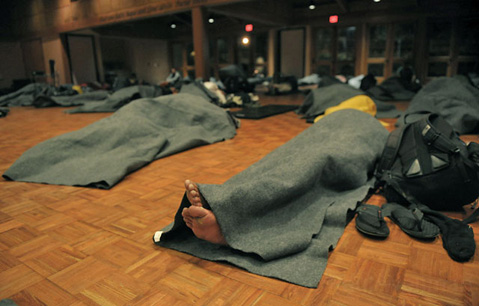Plan Hatched to Keep Homeless Dry
County Approves Funding for Shelters During El Nino Storms

To help keep homeless people dry during the predicted El Niño storms, the Santa Barbara County Supervisors voted to tap into contingency funds set aside for rainy days to the tune of $128,000. Of that, $91,000 will be used to lease two large spaces — one in Santa Maria, the other in Santa Barbara — during daytime hours. In Santa Barbara, it still remains up in the air whether Earl Warren Showgrounds will provide the daytime shelter, or if the downtown armory will.
While the armory is closer to where the homeless are, the process of getting the lease approved and activated is more bureaucratically cumbersome. Both cost $400 for every 12 hours. The plan, according to 3rd District Supervisor Doreen Farr, is to accommodate up to 150 individuals — in two locations — for up to 35 days of El Niño rains. The supervisors also authorized spending an additional $37,000 to keep the five pop-up warming centers operating out of churches activated for 50 nights.
Those centers, which open only when the temperature drops below 35 degrees or the chance of rain exceeds 50 percent for two consecutive nights, have seen three times as many guests this year than last. Already this year, warming centers have been activated 27 nights. This time last year, it was half that many. The one warming center run in Santa Maria has seen its guest list jump from 15-20 a night to 55-60. That center has only one bathroom. South Coast locations report a similar rate of increase.
When the rains come, the supervisors heard, the homeless seek shelter by walking the aisles of stores like Target, pretending to shop, hunkering down in fast food restaurants, visiting the emergency rooms, getting sent to jail, or congregating at the nearest library. During the last heavy rains, downtown library administrators opened their doors early because so many people were waiting to get in from the rain.
Supervisors Doreen Farr and Steve Lavagnino spearheaded efforts to devise a plan to shelter the homeless during daytime hours. Whether one’s motivation was humanitarian or pecuniary, Lavagnino said, providing daytime relief for the homeless during El Niño was “the right thing to do.” Farr likened emergency precautions for the homeless to the county spending money to distribute sandbags. Being wet and cold, she said, poses a serious risk to anyone, let alone people whose health is already compromised. She described the $128,000 authorization as “a life insurance” for the 1,400 homeless people estimated to live in Santa Barbara County. Of those, Lavagnino said, the average age was 43, and the average time of homelessness was 5.5 years.
Peter Marin, a longtime homeless-rights advocate, praised the supervisors’ decision as the most cost effective he’s seen them make in 45 years. He took exception, however, to requiring two consecutive nights of predicted rains and urged the supervisors to change it to just one. “People don’t stay dry when there’s only one night of rain,” he said



